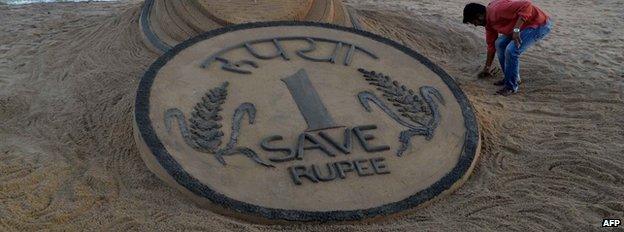India's economic slowdown sparks crisis talk
- Published

India's rupee is the one of the worst performing currencies in the world this year adding to its woes
The gravity of any crisis facing a nation can often be judged by the one to which it is being compared.
In the US, the peak of the 2008-09 global financial crisis saw references made to the Depression of the 1930s.
Over in Greece, the country's debt problems in recent years triggered comparisons with Argentina's default back in 2001, which at the time was the biggest sovereign default in history.
In India's case, its recent economic issues have sparked talks of a repeat of the situation it faced in 1991, often considered its worst economic crisis.
The crisis saw its currency tumble and its foreign exchange reserves depleted. Things turned so bad that India eventually had to be rescued by the International Monetary Fund.
Analysts say the situation in India is not as bad as it was then. The country now has reserves to support nearly seven months of imports, compared with just under 15 days back then. Even so, the signs are worrying.
"The very fact that it is being compared to that situation shows the seriousness of the concerns over the situation," says Tony Nash, vice president at IHS.
"There is no doubt that things are pretty bad in India."
Growing problems
One of the key areas of concern is India's burgeoning current account deficit, which hit a record high of 6.7% of gross domestic product (GDP) last year.
A current account deficit happens when the country's import bill is bigger than its earnings from exports. A widening deficit puts strain on the nation's foreign exchange reserves.
India's position has been further complicated by the fact that foreign investors have been withdrawing money from the economy.
International investors have pulled out nearly $12bn in shares and debt from India's markets since the beginning of June, hurting the stock markets as well as its currency.
The Indian rupee has fallen more than 20% against the US dollar since the start of this year. That has made India's imports more expensive and added to the country's economic problems.
Investors have been pulling out for a variety of reasons, not least the slowdown in its economy, as well as a recovery in the US.
"If you are an investor and you want to put your money in a riskier economy, you are looking to have the capacity of making a much better return than you would get in a more stable economy," says Stuart Oakley, head of Asia currency trading at Nomura.
"India is no longer providing that option, as the growth differential between India and the US has collapsed."
India's economy grew by 4.4% in the April-June quarter. The US economy expanded at an annualised rate of 2.5% in the second quarter.
'Crisis of credibility'
For their part, India's policymakers have been taking steps not just to stem the rupee's decline, but also to attract a fresh wave of foreign investment to the country.
But so far, they have little to show for their efforts.
The country opened up its multi-brand retail sector, seen by many as a key growth area, to foreign investors last year. But as yet, none of the big brands have expressed an interest to enter the market.
Analysts say the key factor is that investors are worried about a lack of continuity in policy changes.
"There is a huge divergence in the views and the stance of the two major political parties on the issue of foreign direct investment in retail," says Siddhartha Sanyal, chief India economist at Barclays.
And with elections due next year, many fear that policies may change depending on which party comes to power.
"They are really at the precipice of a crisis of credibility. Investors have become sceptical whether a new government will have the mandate, the backing and the drive to carry on reforms," says Mr Nash.
Once again, the slowdown in India's economy has only made things more difficult.
"Foreign investors may have still taken some kind of a calculated risk, if there was growth momentum in the country," says Mr Sanyal of Barclays.
"But if you are a big business, right now you would say, 'Let me just wait and watch and see how things develop, because I am not losing much in any case.'"
In a recent interview with India's CNN-IBN channel, external, Ratan Tata, one of the country's leading and most respected business leaders, warned that India has "lost the confidence of the world".
Double whammy
To make matters more complicated, India's policymakers are facing a tricky situation.
The slowdown in economic growth has triggered calls for easing of monetary policy, to help businesses and consumers get through this difficult period.
However, the continued decline in the rupee - coupled with a surge in prices of essential items, such as onions - has limited the scope for any major moves.
Analysts say that given the various factors, the most important thing that India needs to do is restore faith among international investors.
They say that will help attract investments, which in turn will help boost economic growth and also help prop up the currency.
"India is a country of 1.2 billion consumers - so there is clearly a huge amount of potential, no one can deny that - and foreign companies want to be there," says Mr Oakley.
"But they need overwhelming reforms, not just on the policy front, but also on how the whole system works to attract these investors."
The crisis of 1991 is credited to have sparked the first major reforms in the country, which resulted in years of robust growth.
While the problem this time around may not be as bad as then, analysts say the solution is the same.
Hopefully for India, the result will be too.
- Published30 August 2013
- Published29 August 2013
- Published27 August 2013